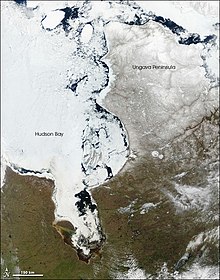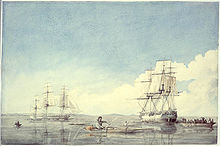Hudson Bay
|
Hudson Bay Hudson Bay |
|
|---|---|
| Hudson Bay | |
| Art | Randmeer |
| ocean | Northern ocean |
| location | Canada (North America) |
| Important islands | Belcher Islands , Ottawa Islands |
| Data | |
| surface | 1,230,000 km² |
| Middle deep | 100 m |
Coordinates: 60 ° N , 85 ° W
The Hudson Bay ( French Baie d'Hudson , Inuktitut Kangiqsualuk Ilua , German also Hudsonbai or Hudson Bay ) is a 1.23 million km² large marginal sea in the northeastern part of Canada . The Canadian provinces of Manitoba , Ontario , Québec and the territory of Nunavut share in the bay, which is connected to the Atlantic by the Hudson Strait . Hudson Bay is named after Henry Hudson , who discovered the bay for Europeans in 1610.
geography
General
From the confluence on the Hudson Strait to the southern end of James Bay , a bay belonging to the Hudson Bay, the Hudson Bay reaches a length of almost 1,400 km, while the greatest distance from the Ungava Peninsula (Québec) to the opposite coast from Nunavut is a little less than 1000 km. While the area of Hudson Bay including the Hudson Strait , James Bay, Ungava Bay and Foxe Basin is 1.23 million km², the actual Hudson Bay without these sub-seas has an area of only 822,324 km². The water volume is 200,000 km³, the mean water depth about 130 meters (greatest depth 258 meters). There are numerous islands in the bay, of which Southampton Island at the entrance to the bay in the north is by far the largest, followed by Coats Island and Mansel Island , also at the entrance to the bay. Akimiski in James Bay should also be mentioned . There are also many small islands in front of James Bay, which are grouped together to form the Belcher Islands . All the islands in the bay belong to Nunavut.
Hudson Bay was formerly considered the bay of the Atlantic Ocean, but it is also connected to the Arctic Ocean by the Foxe Channel and Foxe Basin . In the southwestern part, the bay receives water from several larger rivers, of which the Grande rivière de la Baleine (Québec), Churchill River and Nelson River (Manitoba) are the most important. Hudson Bay is connected to Lake Winnipeg via the latter .
Hudson Bay is navigable for maritime shipping , but only of minor importance. She played an important role in the development of the Canadian hinterland by the Hudson's Bay Company .
Rivers
- Albany River , Ontario
- Attawapiskat River , Ontario
- Rivière Broadback , Quebec
- Churchill River , Manitoba
- La Grande Rivière , Quebec
- Grande rivière de la Baleine ( English Great Whale River ), Québec
- Hayes River , Manitoba
- Moose River , Ontario
- Rivière Nastapoka , Quebec
- Nelson River , Manitoba
- Rivière Nottaway , Quebec
- Rivière Rupert , Quebec
- Severn River , Ontario
- Winisk River , Ontario
climate
Hudson Bay has a tundra and taiga climate . In winter the bay is icy, which is why it is also known as the “North America ice cellar” . However, due to global warming , the ice is thawing earlier and earlier, which is increasingly a threat to the polar bears living there . The most important food for them is the seals , to which they can only get through the frozen Hudson Bay.
history
The Englishman Henry Hudson explored the bay from August 2, 1610 with his ship Discovery . On his fourth and final voyage by ship, he sailed into the bay along the west coast of Greenland and mapped a large part of the east coast there. In the winter, the Discovery was trapped in ice, with the crew surviving on land at the southern end of James Bay. When the ice thawed in the spring, Hudson wanted to explore the rest of the bay. However, the crew mutinied on June 22, 1611. In search of Hudson, Thomas Button explored the west bank of Hudson Bay in 1612/13. He mapped the area and discovered the mouth of the Nelson River and Mansel Island .
60 years later the ship Nonsuch reached the bay and successfully traded beaver fur with the Cree Indians . This led to the founding of the Hudson's Bay Company , which bears this name to this day. The British Crown granted the Hudson Bay Society a monopoly of trade with the Indians in the catchment area of the body of water called Rupert's Land . France denied the land allocation and sent various military expeditions to the region. However, due to the Treaty of Utrecht in April 1713, it had to give up its claims.
During this period, the company built forts and trading posts at the mouths of the main rivers. These included Fort Severn, Ontario, York Factory (Manitoba), and Churchill (Manitoba) . The strategic location allowed expeditions inland and, more importantly, facilitated trade with the local population. The Indians brought furs to the post, where they were shipped straight to Europe (which was a shorter route than from Montreal ). The Hudson's Bay Company used these posts until the beginning of the 20th century.
The land with an area of 3.9 million km² was ceded to Canada in 1870 and part of the Northwest Territories when the trade monopoly was abandoned. As a result of a name change, Hudson's Bay is now called Hudson Bay, which often leads to confusion with society.
population
The Hudson Bay region is extremely sparsely populated. It is dominated by the Inuit and the Cree Indians, who live mainly from hunting and fishing.
Hudson Bay settlements include:
|
|
Protected areas
There are several protected areas in the area of the huge bay. The Polar Bear Provincial Park with an area of around 23,552 km², the largest and northernmost park in Ontario, protects the polar bear population there. The Wapusk National Park, which is even more important here, with around 11,500 km² is already in Manitoba . To the northwest of the bay is the Ukkusiksalik National Park with an area of 20,000 km².
Web links
Individual evidence
- ^ Hudson Bay ( English, French ) In: The Canadian Encyclopedia . Retrieved August 21, 2016.
- ↑ http : // kids. britica.com/comptons/article-9274970/Hudson-Bay





